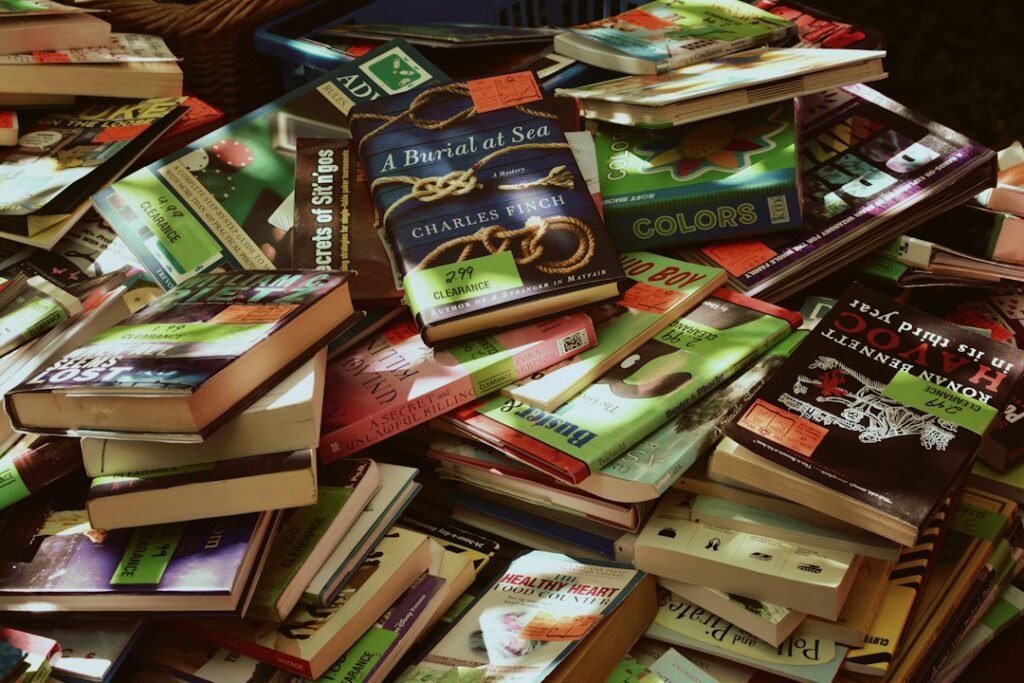Book disposal and recycling are important practices that help reduce waste and protect the environment. In this blog post, we will explore the impact of book disposal on the environment, the difference between recyclable and non-recyclable books, common misconceptions about recycling books, how to identify recyclable books, the recycling process for books, creative ways to repurpose old books, the benefits of donating books instead of recycling, the impact of e-books on book recycling, how to dispose of non-recyclable books responsibly, and the importance of book recycling in reducing landfill waste.
The purpose of this blog post is to raise awareness about the importance of responsible book disposal and provide readers with information and resources to make informed decisions about what to do with their old books. By understanding the environmental impact of book disposal and learning about alternative options such as recycling, repurposing, and donating, readers can contribute to a more sustainable future.
Key Takeaways
- Book disposal has a significant impact on the environment, contributing to landfill waste and greenhouse gas emissions.
- Recyclable books are those made of paper and cardboard, while non-recyclable books contain materials like plastic, metal, or glue.
- Common misconceptions about recycling books include that all books are recyclable and that recycling is the only option for disposal.
- To identify recyclable books, look for the recycling symbol or check with your local recycling program.
- The recycling process for books involves shredding, pulping, and reusing the paper fibers to make new products.
- Repurposing old books can be a creative alternative to recycling, such as using them for art projects or donating them to schools or libraries.
- Donating books can have a positive impact on communities and reduce the need for new book production.
- E-books have a minimal impact on book recycling, as they do not contribute to physical waste.
- Non-recyclable books should be disposed of responsibly, such as through incineration or specialized waste management programs.
- Book recycling is an important step in reducing landfill waste and promoting sustainability.
Understanding the impact of book disposal on the environment
Book disposal has a significant impact on the environment. When books are thrown away in regular trash bins, they end up in landfills where they take up valuable space and contribute to greenhouse gas emissions. According to the Environmental Protection Agency (EPA), paper and paperboard products, including books, make up about 26% of solid waste in landfills.
In addition to taking up space in landfills, the production of books also has environmental consequences. The process of making paper involves cutting down trees and using large amounts of water and energy. By disposing of books without considering their environmental impact, we are contributing to deforestation, water pollution, and increased carbon emissions.
Statistics show that a staggering number of books are disposed of each year. According to a report by the American Library Association (ALA), public libraries in the United States alone discard over 30 million pounds of books each year. This does not include books discarded by individuals, schools, and other institutions. These numbers highlight the need for responsible book disposal practices.
The difference between recyclable and non-recyclable books
Not all books are recyclable, and it is important to understand the difference between recyclable and non-recyclable books. Recyclable books are made from materials that can be processed and turned into new products. These materials include paper, cardboard, and certain types of binding glue.
On the other hand, non-recyclable books are made from materials that cannot be easily recycled or are not accepted by recycling facilities. These materials may include plastic-coated covers, spiral bindings, or certain types of adhesives. Non-recyclable books often end up in landfills because they cannot be processed through traditional recycling methods.
Examples of recyclable books include paperback novels, textbooks with soft covers, and hardcover books with removable dust jackets. Examples of non-recyclable books include textbooks with plastic covers, spiral-bound notebooks, and books with glued bindings that cannot be easily removed.
Common misconceptions about recycling books
There are several common misconceptions about recycling books that need to be addressed. One misconception is that all paper products can be recycled. While it is true that many paper products can be recycled, not all paper is created equal. Books with certain types of bindings or coatings may not be accepted by recycling facilities.
Another misconception is that recycling books is not worth the effort because the recycling process itself has negative environmental impacts. While it is true that recycling does require energy and resources, it is still a more sustainable option than sending books to landfills where they will take up space indefinitely.
It is also a common misconception that donating books is a better option than recycling them. While donating books is a great way to extend their lifespan and benefit others, not all donated books are suitable for reuse. Many organizations have limited storage space and can only accept books that are in good condition and meet their specific criteria.
How to identify recyclable books
Identifying recyclable books can be a bit tricky, but there are some tips that can help. First, look for books with paper or cardboard covers. These are more likely to be recyclable than books with plastic or laminated covers. Second, check if the book has a removable dust jacket. If it does, it is likely that the book itself is recyclable even if the dust jacket is not.
Another way to identify recyclable books is to look for recycling symbols or labels on the book or its packaging. These symbols indicate that the book is made from recyclable materials and can be processed through traditional recycling methods.
It is important to note that not all recycling facilities accept books, so it is a good idea to check with your local recycling center or waste management facility to see if they accept books for recycling. If they do not, they may be able to provide information on alternative options for responsible book disposal.
The recycling process for books

The recycling process for books involves several steps. First, the books are collected and sorted at a recycling facility. This sorting process separates books from other types of paper waste and removes any non-recyclable materials such as plastic covers or bindings.
Once the books have been sorted, they are shredded into small pieces. This shredding process breaks down the books into fibers, which can then be used to make new paper products. The shredded book fibers are mixed with water to create a pulp, which is then cleaned and refined to remove any impurities.
After the pulp has been cleaned and refined, it is spread out onto a screen or mesh conveyor belt to remove excess water and form sheets of paper. These sheets are then pressed and dried to remove any remaining moisture. Finally, the dried sheets of paper are rolled into large rolls or cut into smaller sheets, ready to be used in the production of new paper products.
Creative ways to repurpose old books instead of recycling
If you have old books that are not suitable for recycling, there are many creative ways to repurpose them instead of sending them to the landfill. One idea is to turn old books into decorative objects such as book sculptures or book art. By folding, cutting, or manipulating the pages of the book, you can create unique and visually appealing pieces of art.
Another option is to use old books for crafts and DIY projects. You can make bookmarks, coasters, or even jewelry using the pages of old books. The possibilities are endless, and there are many online resources and tutorials available to help you get started.
If you have a large collection of old books, you could consider creating a mini-library or bookshelf using the books themselves. By stacking and arranging the books in a creative way, you can create a functional and visually interesting piece of furniture.
The benefits of donating books instead of recycling
Donating books is a great way to extend their lifespan and benefit others. When you donate books, you give someone else the opportunity to read and enjoy them. This is especially important for educational institutions, libraries, and individuals who may not have access to a wide range of reading materials.
In addition to benefiting others, donating books also helps reduce waste and conserve resources. By giving your books a second life, you are preventing them from ending up in landfills where they would take up space indefinitely. This reduces the demand for new books and the resources required to produce them.
There are many organizations that accept book donations, both locally and internationally. Local libraries, schools, and community centers often have book donation programs in place. There are also national and international organizations that collect and distribute books to underserved communities around the world.
The impact of e-books on book recycling
The rise of e-books has had a significant impact on book recycling. With the increasing popularity of digital reading devices such as e-readers and tablets, more and more people are opting for electronic versions of books instead of physical copies.
While e-books offer many advantages such as convenience and portability, they also have environmental benefits. E-books do not require paper, ink, or physical transportation, which reduces the carbon footprint associated with traditional book production and distribution.
However, it is important to note that e-books are not completely without environmental impact. The production and disposal of electronic devices, as well as the energy required to power them, contribute to greenhouse gas emissions and electronic waste. It is also worth considering the environmental impact of the mining and extraction of the minerals used in electronic devices.
How to dispose of non-recyclable books responsibly
If you have non-recyclable books that cannot be repurposed or donated, it is important to dispose of them responsibly. One option is to check if there are any specialized recycling programs or facilities in your area that accept non-recyclable books. These programs may use alternative methods to recycle or repurpose non-recyclable materials.
If there are no specialized recycling programs available, you can try contacting your local waste management facility or landfill to see if they have any recommendations for responsible disposal. They may be able to provide guidance on how to separate non-recyclable books from other types of waste or direct you to facilities that can handle non-recyclable materials.
It is important to avoid throwing non-recyclable books in regular trash bins as they will end up in landfills where they will take up space indefinitely. By taking the time to find alternative disposal options, you can ensure that your non-recyclable books are handled in a responsible and environmentally friendly manner.
The importance of book recycling in reducing landfill waste
Book recycling plays a crucial role in reducing landfill waste. By recycling books, we can divert them from landfills where they would take up valuable space and contribute to greenhouse gas emissions. According to the EPA, recycling one ton of paper can save 3.3 cubic yards of landfill space.
In addition to reducing landfill waste, book recycling also helps conserve resources. By using recycled paper fibers instead of virgin materials, we can reduce the demand for logging and the energy and water required to produce new paper products. This helps protect forests, conserve water, and reduce carbon emissions.
Statistics show that book recycling has a significant impact on reducing landfill waste. According to the ALA, public libraries in the United States recycle over 20 million pounds of books each year. This is a significant amount of waste that is being diverted from landfills and turned into new paper products.
In conclusion, book disposal and recycling are important practices that help reduce waste and protect the environment. By understanding the impact of book disposal on the environment, identifying recyclable books, learning about the recycling process, and exploring alternative options such as repurposing and donating, we can make informed decisions about what to do with our old books.
It is important to remember that not all books are recyclable, and it is crucial to properly identify recyclable books before sending them for recycling. Additionally, repurposing old books can be a creative and sustainable alternative to recycling or disposing of them in landfills.
By recycling or repurposing our old books instead of throwing them away, we can contribute to a more sustainable future and help reduce landfill waste. It is important for individuals, institutions, and communities to take responsibility for their book disposal practices and make conscious choices that prioritize environmental conservation.


